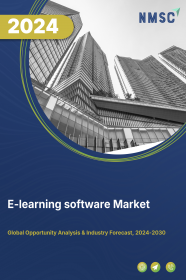
E-learning Software Market by Provider (Content and Service), by Deployment Model (On-Premise and Cloud), by Learning Mode(Self-Paced and Instructor-Led), by Course (Academic Course and Professional Course), by Pricing Model (Subscription-Based Models, One-Time Purchase Models, and Pay-Per-Use Models), and by End-user (Individual, Academic, Corporate, and Government)-Global Opportunity Analysis and Industry Forecast 2022-2030
US Tariff Impact on E-learning software Market
Trump Tariffs Are Reshaping Global Business
Market Definition
The E-learning Software Market size was valued at USD 210.18 billion in 2021 and is predicted to reach USD 819.96 billion by 2030 with a CAGR of 16.6% from 2022-2030.
E-learning software enables the online delivery of educational material and provides an interactive learning experience for students. It is typically used in a virtual classroom setting, where students can gain access to lectures, practice tests, and other forms of educational material through internet-connected devices. The software also provides tools for instructors to create, manage, and deliver content to students.
E-learning software generally includes a range of interactive multimedia components such as audio, video, simulations, and gamification. Some e-learning software solutions also feature tracking systems that allow instructors to monitor the progress of students. This software can also be used for assessment, allowing instructors to evaluate the performance of their students. In addition, the software can be used for collaboration, allowing students to interact with each other and work together on projects.
Market Dynamics and Trends
The demand for the e-learning software market is witnessing a significant boost owing to the growing demand for cost-effective, convenient, and flexible learning solutions for learners,allowing them to study at their place as per their convenience.Moreover, the use of multimedia tools such as videos, simulations, and interactive activities to provide a superior learning experience over traditional classroom instructions is further driving the growth of the e-learning software market. Furthermore, the surging adoption of internet-enabled devices such as smartphones and tablets along with the rising acceptance of mobile learning is further proliferating the growth of the e-learning software market.
The lack of internet connectivity in remote areas and poor telecommunication infrastructure in rural areas of developing countries are the major factors restraining the growth of the e-learning software market. On the contrary, the introduction of augmented reality (AR), virtual reality (VR), and interactive game-based online learning platforms to create revolutionary and innovative learning experiences is expected to create ample opportunities for the e-learning software market in the coming years.
Market Segmentations and Scope of the Study
The e-learning software market is segmented on the basis of provider, deployment model, learning mode, course, pricing model, and end-users. On the basis of provider, the market is divided into content and service. On the basis of deployment model, the market is classified into on-premise and cloud. On the basis of learning mode, the market is segmented into self-paced and instructor-led. On the basis of course, the market is divided into academic courses and professional courses. The academic courses are further divided into K-12 and higher education. On the basis of pricing model, the market is segmented into subscription-based, one-time purchase, and pay-per-use models. On the basis of end-user, the market is divided into individual, academic, corporate, and government.Geographic breakdown and analysis of each of the aforesaid segments include regions comprising North America, Europe, Asia-Pacific, and RoW.
Geographical Analysis
North America held the lion’s share in the e-learning software marketin 2021 and is expected to continue its dominance during the forecast period. This is due tothe increase in the number of students opting for online learning due to the convenience and cost-effectiveness offered by e-learning platforms in countries such as the US and Canada.
According to the World Economic Forum, more than 17 million people used e-learning platforms and online learning tools in the US,as of 2022. Moreover, the presence of key market players such as Alphabet Inc and Oracle plays an important role in the development of the e-learning software market in this region.
For instance, in December 2022, Alphabet Inc. announced its plans tolaunch numerous educational courses on Youtube in India in 2023. The company aims to provide a platform for creators to offer both free and paid educational courses, and also share educational materials such as documents, images, and PDFs in a structured learning experience.
On the other hand, Asia Pacific is expected to show a steady rise in the e-learning software market during the forecast period, due to the growing popularity of the IoT and smart devices such as smartphones, tablets, and laptops along with the rapid digitalization in countries such as China, India, and Japan.With the growing penetration of smart devices among students, the popularity of e-learning software and platforms is significantly boosted in this region. According to the China Academy of Information and Communications Technology, China's digital economy reached USD 6.6 trillion in 2021.
Moreover, the growing initiatives and supportive policies adopted by the governments of countries such as India and China are driving the growth of the e-learning software market. According to the Government of India’s union budget 2021-22, the Indian government established the National Digital Educational Architecture (NDEAR) to strengthen the digital infrastructure and support activities related to education planning, as the active internet users in India are estimated to reach 900 million by 2025.
Competitive Landscape
The key market players operating in the e-learning software market include Anthology Inc., Adobe Inc., Coursera Inc., LinkedIn Learning, Udemy, Skillsoft, edX, Pluralsight, SAP, Cisco Systems, Inc., and others.These market players are adopting various strategies such as product launches, partnerships, and collaborations to remain dominant in the market.
For instance, in December 2022, Simplilearn partnered with Commonwealth Secretariat to release over 2,000 free e-learning courses for young learners living in the Caribbean. The online trainingincludes artificial intelligence, machine learning, data science, cybersecurity, and software development courses.
Moreover, in August 2022, Coursera collaborated with Woxsen University, Telangana, to integrate skill-based online learning programs into its curriculum across the business, technology, and design schools. Through this collaboration, the company aims to provide 5000+ certifications in areas of data analytics, business strategy, fashion design, and HR analytics.
Furthermore, in July 2021, Adobe Launched Adobe Analytics for higher education to provide advanced digital literacy. Through this launch, the company aims to provide college instructors and students data analytics platforms for free and get access to the course curriculum.
Key Benefits
-
The e-learning software market report provides a quantitative analysis of the current market and estimations from 2022 to 2030. This analysis assists in identifying the prevailing market opportunities to capitalize on.
-
The study comprises a detailed analysis of the e-learning software market trends including the current and future trends for depicting the prevalent investment pockets in the market.
-
The information related to key drivers, restraints, and opportunities and their impact on the e-learning software market is provided in the report.
-
The competitive analysis of the market players along with their market share in the e-learning software market is mentioned.
-
The SWOT analysis and Porter’s Five Forces model are elaborated in the study.
-
The value chain analysis in the market study provides a clear picture of the stakeholders’ roles.
Key Market Segments
By Provider
-
Content
-
Service
By Deployment Model
-
On-Premise
-
Cloud
By Learning Mode
-
Self-paced
-
Instructor-led
By Course
-
Academic Course
-
K-12
-
Higher Education
-
-
Professional Course
By Pricing Model
-
Subscription-Based Models
-
One-Time Purchase Models
-
Pay-Per-Use Models
By End-user
-
Individual
-
Academic
-
Corporate
-
Government
By Geography
-
North America
-
U.S
-
Canada
-
Mexico
-
-
Europe
-
Germany
-
France
-
Italy
-
Spain
-
United Kingdom
-
Russia
-
Sweden
-
Rest of Europe
-
-
Asia-Pacific
-
Australia
-
China
-
India
-
Japan
-
South Korea
-
Indonesia
-
Singapore
-
Rest of Asia-Pacific
-
-
RoW
-
UAE
-
Brazil
-
South Africa
-
Israel
-
KSA (Kingdom of Saudi Arabia)
-
Turkey
-
Remaining Countries
-
KEY PLAYERS
-
Anthology Inc.
-
Adobe Inc.
-
Coursera Inc.
-
LinkedIn Learning
-
Udemy
-
Skillsoft
-
edX
-
Pluralsight
-
SAP
-
Cisco Systems, Inc.

















 Speak to Our Analyst
Speak to Our Analyst




















